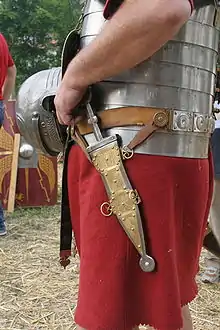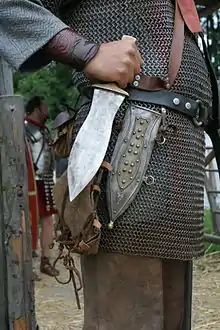Pugio
The pugio (plural: pugiones) was a dagger used by Roman soldiers as a sidearm. It seems likely that the pugio was intended as an auxiliary weapon, but its exact purpose to the soldier remains unknown. Officials of the empire took to wearing ornate daggers in the performance of their offices, and some would wear concealed daggers as a defense against contingencies. The dagger was a common weapon of assassination and suicide; for example, the conspirators who stabbed Julius Caesar used pugiones.[1][2] The pugio was descended from the daggers used by the Cantabarians.[2]
 |
| Part of a series on the |
| Military of ancient Rome |
|---|
|
|


Usage
Like the gladius, the pugio was probably a stabbing weapon, the type of weapon said to have been preferred by the Romans. Of them, late Roman writer Vegetius, said it "was the method of fighting principally used by the Romans"[3]Vegetius may be overstating this point however, as there are a number of surviving Roman depictions of soldiers slashing with their weapons in addition to stabbing with them. This is shown best on the Adamklissi metopes.
The pugio was a very popular weapon among the Romans. With both Auxiliary soldiers and Legionaries using the weapon.[2] This does not mean however, that the pugio was carried universally. The light infantry and cavalry of the Roman army did not carry pugiones.[2]
In the pages of Cicero, the pugio appears to have been the favoured weapon for high-ranking assassination and suicide because it was so easily concealed in the folds of flowing Roman garments. The pugio was used by Marcus Brutus to stab Julius Caesar.[4] Suetonius confirms that all the conspirators used pugiones on that occasion and some later killed themselves with it.[5]
Pugiones became ornate sidearms of officers and dignitaries as well, a custom reminiscent of the knives after which the Saxons were named. These Germanic mercenaries served in the Roman army. The emperors came to wear daggers to symbolize the power of life and death.[6] The emperor Vitellius attempted to resign his position and offered his dagger to the consul, but it was refused and Vitellius was forced to stay by popular acclaim and the Praetorian guard. Tacitus also relates[7] that a centurion, Sempronius Densus, of the Praetorian guard, drew a dagger to save Lucius Calpurnius Piso Licinianus momentarily. Soldiers would own pugiones not because they believed the weapon was useful to them, but because the weapon was prestigious.[2]
References to the pugiones are more common in the literature of the empire, especially in Tacitus and Suetonius. Tacitus reports[2] that Gnaeus Domitius Corbulo had a soldier executed for not wearing a sword while digging a trench and another for wearing only a pugio in the same activity. This does not mean however, that the pugio was carried universally and a study of 1st century AD figural tombstones reveals that there were certainly soldiers who did not carry pugiones. The evidence of a preserved 1st century AD writing tablet also reveals that some cavalrymen also carried pugiones.
The pugio seems to have been carried much less during the 2nd century AD and when it did reappear in large numbers early in the 3rd century AD, the blades had become much larger and the pommel expansion on the handle had become crescent shaped. These later daggers seem always to have been carried in 'frame type' sheaths.
Forging
By the early 1st century AD the pugio typically had a large blade. Some pugiones had 'leaf-shaped' blades. Other pugiones had narrowed from the shoulders to run parallel to about half the blade's length, before narrowing to a sharp point.
A midrib ran close to the length of each side, either standing out from the face or sunken and defined by grooves on either side. The tang was wide and flat initially, and the grip was riveted through it, as well as through the shoulders of the blade. The pommel expansion was originally round but by the early 1st century AD this was being replaced by a pommel expansion typically of a bulbous, roughly trapezial shape, often topped by three decorative rivets.
_01.jpg.webp)
The pugio was accommodated in its own sheath. By the second quarter of the 1st century AD three types of sheath were in use. All of these had four suspension rings and a bulbous terminal expansion which was pierced by a large rivet. Both depictional evidence and the evidence of wear patterns on surviving examples show that the two lower rings were unused. The first type was made with a curving metal plate that was usually made of iron at both the front and back of the sheath. This plate surrounded wooden 'lining'. The front plate was usually heavily decorated with inlaid brass, silver, niello and red, yellow or green enamel. These sheaths featured round free-running suspension rings, attached by bifurgated mountings which were riveted on. Modern reconstructions of these sheaths which feature applied brass plates attached by rivets are incorrect and nothing of this type has ever been found. The second type was a wooden sheath, probably covered with leather to the front of which a metal (almost always iron) plate had been attached. This plate was fairly flat and was heavily decorated with inlaid silver (or occasionally tin) and enamel. The suspension rings resembled small Roman military buckles and were hinged to the sides of the sheath. The third type ('frame type') was made of iron and consisted of a pair of curved channels which ran together at the lower end of the sheath, where they were normally worked into a flattened round terminal expansion and pierced with rivet, although there is an example from Titelberg whose channels have been inserted into a bulbous terminal formed with a ferule to accept the channels before a decorated rivet has been used to fix all three elements together. The channels were joined by two horizontal bands at the top and middle of the sheath and these bands also retained the suspension rings. These sheaths would have been built around a wooden core, which does not survive in the archaeological record.
Like other items of legionary equipment, the dagger underwent some changes during the 1st century AD. At some time in the first half of the 1st century AD a rod tang was introduced, and the hilt was no longer riveted through the tang and was instead secured only at the shoulders of the blade. This in itself caused no great change to the pugio's appearance, although the archaeological evidence strongly suggests that the rod tang was less secure and that handles attached in this way could become detached, a possibility that may be proved by the existence of two surviving pugiones from different sites which both retain replacement handles, one of which is a recycled sword grip. Some of the blades associated with rod tangs were narrower (under 4.5 cm (1.75 in) wide), with little or no waisting, or reduced or virtually non-existent midribs (type 'C' blades).
Throughout the period the outline of the hilt remained essentially the same. Like the earlier period it was made with two layers of horn, wood or bone sandwiching the tang, each overlaid with a thin iron plate, which could either be solid, becoming thinner at both the guard and the pommel expansion, which was roughly trapezial in shape, or made of thin metal embossed to this shape. The hilt was often decorated with silver inlay. The hilt is 10 cm to 13 cm (4 in - 5 in) long overall and that the grip is quite narrow, the presence of an expansion in the centre of the grip provides for a very secure grip.
In size the pugio ranged from 18 cm to 28 cm (7 in to 11 in) long and 5 cm (2 in) or more in width.
Etymology
The word pūgiō derives from the word pungo. The root of the word is pug. The word derives from the Proto-Indo-European root *peuĝ.[2][8] It is still possible to use punch and stab synonymously in many Indo-European languages; hence, Latin pugnus and Greek πυγμή pygmḗ mean "fist". The Smith article cited below proposes that the pugio was the weapon grasped by the fist; however, the Latin word for swordplay was pugna, an exchange of thrusts without the intermediary of fists, although it could also be a fistfight.
Notes
- For references to the numerous instances of murder and suicide with the dagger in the ancient authors, look up pugio in the Latin, Greek and Roman materials section of www.perseus.com. English translations are available. Some instances in addition to the murder of Julius Caesar are recorded in the following examples: The letter of Servius Sulpicius Rufus to Cicero mentions that Publius Magius Cilo stabbed Marcus Marcellus after dinner and later committed suicide. A letter from Cicero to Atticus states that a young man, Curio, was falsely accused of fomenting a conspiracy to kill Pompey with a dagger. A letter of Pliny the Younger tells the story of Arria, loving wife of Paetus. When he was ordered to kill himself, she went first, stabbing herself with a dagger and exclaiming "It doesn't hurt, Paete."
- Saliola, Marco (2012). Pugio-gladius Brevis Est. Archaeopress, 2012. ISBN 140-730-999-4.
- De Re Militari, Book I. In the link given, the passage is to be found under "NOT TO CUT, BUT TO THRUST WITH THE SWORD."
- 2nd Philippic 2.12.28
- De Vita Caesarum, Life of Julius Caesar, 89.1
- Tacitus, Histories, 3.68
- Work cited, 1.43
- This derivation is given in Köbler, Gerhard, Indogermanisches Wörterbuch under p. It can be found online Archived 2007-02-10 at the Wayback Machine as a displayable .pdf file. Those who do not read German may prefer the American Heritage Dictionary Archived 2006-12-11 at the Wayback Machine, also online, although its derivation does not happen to include pugio.
Sources
- PUGIO, article in Smith, Dictionary of Greek and Roman Antiquities, online at ancientlibrary.com.
- MC Bishop and JCN Coulston - 'Roman Military Equipment (2nd Edition)', Armatura Press, 2006
- I. Scott - 'Roman Military Daggers' in 'A Catalogue of Roman Iron Tools, Weapons and Fittings in the British Museum, 1985
- J. Obmann - 'Studien zu Roemischen Dolchscheiden des 1. Jahrhunderts n. Chr.', Koelner Studien Zur Archaeologie Der Roemischen Provinzen, 2000
External links
- Roman Offensive Weapons: The Dagger / Pugio, Roman Legions site.
- Yahoo Group site devoted to PUGIO study with over 80 photos